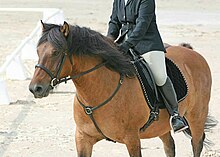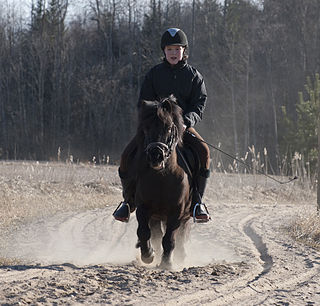
The Shetland pony is a Scottish breed of pony originating in the Shetland Islands in the north of Scotland. It may stand up to 107 cm (42 in) at the withers. It has a heavy coat and short legs, is strong for its size, and is used for riding, driving, and pack purposes.
A Garron or Garran is a type of a small sturdy horse or pony. The term occurs in Scotland and in Ireland, and generally refers to an undersized beast.

The Eriskay Pony is a breed of pony from Scotland. It is generally grey in colour, and has a dense, waterproof coat that protects it in harsh weather. The breed developed in ancient times in the Hebrides of Scotland, and a small population remained pure and protected from crossbreeding by the remoteness of the islands. It is used for light draught work, as a mount for children, in many equestrian disciplines, and for driving.

The Dartmoor Pony is a breed of pony that lives in Devon, England. The breed has been in England for centuries and is used in a variety of roles. Because of the extreme weather conditions experienced on the moors, the Dartmoor Pony is a particularly hardy breed with excellent stamina. Over the centuries, it has been used as a working animal by local tin miners and quarry workers. It is kept in a semiferal state on Dartmoor.
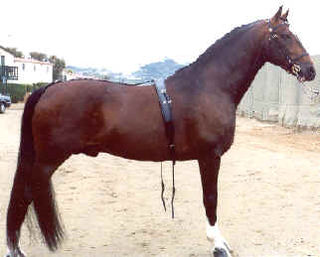
The Hackney is a recognized breed of horse that was developed in Great Britain. In recent decades, the breeding of the Hackney has been directed toward producing horses that are ideal for carriage driving. They are an elegant high stepping breed of carriage horse that is popular for showing in harness events. Hackneys possess good stamina, and are capable of trotting at high speed for extended periods of time.

The Dales Pony is a British breed of pony or small horse. It originated in, and is named for, the Dales of Yorkshire in northern England. It is one the nine native mountain and moorland pony breeds of the United Kingdom, and belongs to the broader Celtic group of ponies which extends from Portugal and northern Spain to Scandinavia.
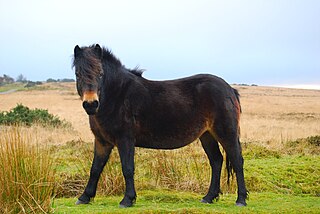
The Exmoor Pony is a British breed of pony or small horse. It is one of the mountain and moorland pony breeds native to the British Isles, and so falls within the larger Celtic group of European ponies. It originates on, and is named for, the Exmoor area of moorland in north-eastern Devon and western Somerset, in south-west England, and is well adapted to the climate conditions and poor grazing of the moor. Some still live there in a near-feral state, but most are in private ownership.
Riding pony is a horse show classification used to refer to certain types of ponies. Competition is divided into sections based on height and type, and include being judged under saddle in standard pleasure horse classes, as well as in related events such as sidesaddle or in-hand.

The Connemara pony is a pony breed originating in Ireland. They are known for their athleticism, versatility and good disposition.
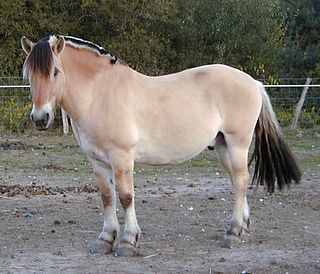
The Fjord or Norwegian Fjord Horse is a relatively small but very strong horse breed from the mountainous regions of western Norway. It is an agile breed of light draught horse build. It is always dun in colour, with five variations in shade recognised in the breed standard. One of the world's oldest breeds, it has been used for hundreds of years as a farm horse in Norway, and in modern times is popular for its generally good temperament. It is used both as a harness horse and under saddle.
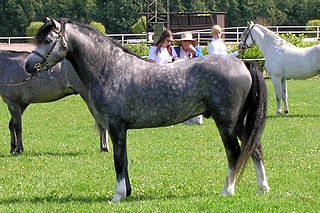
The Welsh Pony and Cob is a group of four closely-related horse breeds including both pony and cob types, which originated in Wales. The four sections within the breed society for the Welsh breeds are primarily distinguished by height, and also by variations in type: the smallest Welsh Mountain Pony ; the slightly taller but refined Welsh Pony of riding type popular as a children's show mount; the small but stocky Welsh Pony of Cob Type, popular for riding and competitive driving; and the tallest, the Welsh Cob, which can be ridden by adults. Welsh ponies and cobs in all sections are known for their good temperament, hardiness, and free-moving gaits.

The Fell pony is a versatile working breed of mountain and moorland pony originating on Cumberland and Westmorland farms of northwest England and is used for riding and driving. The breed is closely related to its geographic neighbour, the Dales Pony, but is a little smaller and more pony-like in build. The Fell Pony is noted for hardiness, agility, strength and sure-footedness.

The Pottok or Pottoka, is an endangered, semi-feral breed of pony native to the Pyrenees of the Basque Country in France and Spain.

The Belted Galloway is a traditional Scottish breed of beef cattle. It derives from the Galloway stock of the Galloway region of south-western Scotland, and was established as a separate breed in 1921. It is adapted to living on the poor upland pastures and windswept moorlands of the region. The exact origin of the breed is unclear, although the white belt for which they are named, and which distinguishes the breed from black Galloway cattle, is often surmised to be the result of cross-breeding with the similarly-coloured Dutch Lakenvelder.
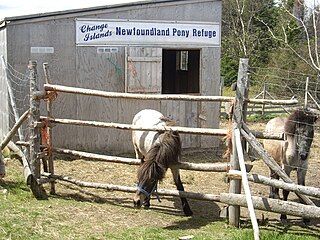
The Newfoundland pony is a breed of pony originating in Newfoundland, Canada. They are sturdy and muscular ponies, found in many colors, including the relatively rare white coloration. The Newfoundland developed from a mix of English, Irish, and Scottish pony breeds brought to Newfoundland by settlers over a period of four centuries. Initially free-roaming, they crossbred to produce the modern type. They were used by settlers as draft and multi-purpose ponies until the mid-20th century century, when they were brought almost to the point of extinction by mechanization and slaughter. The population rebounded slightly after the formation of a breed registry in 1980, but still remains low. In 1997, the Newfoundland pony was declared a heritage breed of Newfoundland and Labrador, which afforded it protection under the law, but the breed has not yet been recognized under the Canadian federal Animal Pedigree Act. As of 2008, there were 248 registered ponies of breeding age, out of a total population of 361. In 2013, the widely dispersed breeding population is still estimated at between 200 and 250 animals.

Horses exhibit a diverse array of coat colors and distinctive markings. A specialized vocabulary has evolved to describe them.

Mountain and moorland ponies form a group of several breeds of ponies and small horses native to the British Isles. Many of these breeds are derived from semi-feral ponies kept on moorland or heathland, and some of them still live in this way, as well as being kept as fully domesticated horses for riding, driving, and other draught work, or for horse showing.

The Heck horse is a horse breed that is claimed to resemble the tarpan, an extinct wild equine. The breed was created by the German zoologist brothers Heinz Heck and Lutz Heck in an attempt to breed back the tarpan. Although unsuccessful at creating a genetic copy of the extinct species, they developed a breed with grullo coloration and primitive markings. Heck horses were subsequently exported to the United States, where a breed association was created in the 1960s.

The Ojibwe Horse, also known as the Lac La Croix Indian Pony and Lac La Croix “Indian” or “Indigenous” pony is a semi-feral Canadian horse breed developed by the Ojibwe people. The population became critically low; and, by 1977, only four mares remained. To preserve the breed, these mares were crossed with Spanish Mustang stallions. The modern breed name derives from the Lac La Croix First Nation of Ontario, where the horses were last found in the wild. Historically, the breed was also found in Minnesota.


